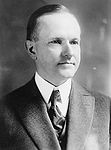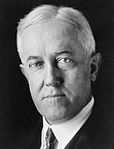U.S. presidential election, 1924
|
|
|||||||||||||||||||||||||||||||||||||
|---|---|---|---|---|---|---|---|---|---|---|---|---|---|---|---|---|---|---|---|---|---|---|---|---|---|---|---|---|---|---|---|---|---|---|---|---|---|
|
|||||||||||||||||||||||||||||||||||||
|
531 electoral votes of the Electoral College 266 electoral votes needed to win |
|||||||||||||||||||||||||||||||||||||
| Turnout | 48.9% |
||||||||||||||||||||||||||||||||||||
|
|||||||||||||||||||||||||||||||||||||
|
Presidential election results map. Red denotes states won by Coolidge/Dawes, blue denotes those won by Davis/Bryan, light green denotes those won by La Follette/Wheeler. Numbers indicate the number of electoral votes allotted to each state.
|
|||||||||||||||||||||||||||||||||||||
|
|||||||||||||||||||||||||||||||||||||
The United States presidential election of 1924 was the 35th quadrennial presidential election, held on Tuesday, November 4, 1924. Incumbent President Calvin Coolidge, the Republican candidate, was elected to a full term.
Coolidge had been vice-president under Warren G. Harding and became president in 1923 when Harding died during his term in office. Coolidge was given credit for a booming economy at home and no visible crises abroad. His candidacy was aided by a split within the Democratic Party. The regular Democratic candidate was John W. Davis, a little-known former congressman and diplomat from West Virginia, and the only person from that state to ever become a candidate for President. Davis was also the first man from a former slave state (including the border states) to be a Presidential candidate since the Civil War, although Tennessee’s Andrew Johnson had served as President after Lincoln was assassinated. Since Davis was a conservative, many liberal Democrats bolted the party and backed the third-party campaign of Senator Robert M. La Follette of Wisconsin, who ran as the candidate of the Progressive Party and by winning his home state became and remains the only person from Wisconsin to win an electoral vote for president.
...
Wikipedia





